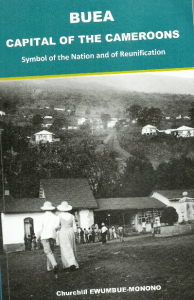By Kanute Tangwa aka K(C)anute Tangwa
 Writing about your town or city is exacting and tricky; the writer is like Chinua Achebe’s lizard that jumped from the high iroko tree to the ground and said he would praise himself if no one else did or a boastful Ozymandias, the King of Kings, who had only ruins and decay to show for his grandeur.
Writing about your town or city is exacting and tricky; the writer is like Chinua Achebe’s lizard that jumped from the high iroko tree to the ground and said he would praise himself if no one else did or a boastful Ozymandias, the King of Kings, who had only ruins and decay to show for his grandeur.
It takes a scholar with feet solidly on the ground like Churchill Ewumbue Monono to realize such a feat since Buea these days is not “running splash of rust” as it then was between 1972 and 1982 but tucked smugly at the foot of the 4070 metre high active volcano, Mount Fako, aka the Chariot of the Gods, alias Mount Cameroon, the highest peak in West and Central Africa, host to rare flora and fauna that the author lists with panache.
According to the author, Buea under German colonial rule, English Mandate and Trusteeship and subsequent Southern Cameroons and West Cameroon administrations- Endeley, Foncha, Jua and Muna was a political hub and a development showcase. He reels off quite a good number of achievements of each administration at the political, social, health, economic, educational, diplomatic and military levels capped ostensibly by the imposing and majestic Schloss (Lodge).
In other words, from 1896 to 1972 Buea witnessed a steady growth in all compartments until the inglorious interregnum (1972 to 1982) when the town nose-dived to an I-Was and One-Way-In-One-Way-Out-Morose-Town status occasioned by an apparent stand-off between political giants- elder statesman and politician, Dr Emmanuel Moka Lifafa Endeley, OBE and one-time powerful minister of Territorial Administration and CNU party apparatchik, Victor Ayissi Mvodo.
As an apologist for the New Deal, the author sees a Buea “running splash of gold” from 1982 till date thanks to the accession to power of a harbinger and keeper of promises, Paul Biya. Indeed, a refurbished Buea, before and after the 50th independence anniversary celebration is a tourist appeal coupled with its rehabilitated road infrastructure, town hall, grand stand, quality hotels, historical monuments (colonial and indigenous), picturesque landscape and a clement climate.
The author extols the rich history and culture of the indigenous people of Buea, the Bakweri, reputed for their legendary hospitality (first attested to by the Osagyefo Kwame Nkrumah in a memorable 1959 visit to Buea). Banking on the Soppo School of Oral History, the author provides a clue to the origins of the Bakweri in a succinct manner:
“Buea or Ggbea was founded around the 17th century by Eyieh Tama Lifanje, a hunter, who migrated from the Bomboko country. The Bakweri, the indigenes of Buea, are believed to have migrated from the Great Lakes Region, in the North-Eastern Coast of Africa, near Uganda. From there, they moved to Bakota around the Congo, where they settled for several years before migrating to a place called Bule, near Ebolowa, then to a settlement near the Kwakwa River (Dibamba), a tributary of the River Sanaga. From there they migrated to Piti, where because of disagreements with the Baanko people (Bassa, Bakoko), Mokule (Moukouri) Mbedi led a party of the group passing through the creeks until they settled around Bimbia.”
For sure, Buea was founded in 1896 as a German Station but resistance to German rule was exemplified by the venerable Kuve Likenye who fought valiantly against German occupation that paradoxically sowed the seeds of the Kamerun Idea, Kamerun Nationalism and One Kamerun.
Thus, Buea became the focal point for arch nationalists, unificationists and monuments like Karl-Friedrich Otto Atangana (Charles Atangana), Robert Jabea Koum Dibonge, Gabriel Mbene, Paul Monyonge Kale, Peter Motomby Woleta, Dr EML Endeley, Chief Gervasius Mbella Endeley and so on. It also headquartered the major political parties of the day like the KNDP of John Ngu Foncha and hosted most of the crucial pre-and-post plebiscite conferences and meetings between Southern Cameroons and La République du Cameroun.
Thumbing through the book, rich with rare pictures, the reader cannot but be enamoured with a Buea, la belle, that speaks to Cameroon in several ways: Buea in the scramble for Cameroon; Buea the German Mountain Station; capital of German Cameroon; capital of British Cameroons; cradle of the Kamerun Idea and Kamerun Nationalism; birthplace of Official Reunification; capital of the Federated West Cameroon; melting pot of cultures; tourist resort; beacon of Common Law and Civil Liberties; centre par excellence of learning; cradle of bilingualism (the first Bilingual Secondary School and the School of Translators and Interpreters); precursor of the green revolution via Agro-pastoral shows; sports and social development hub; centre of religious effervescence and tolerance; host to the Mountain Cameroon Race of Hope; national unity and national integration laboratory as well as an arts and culture destination.
Definitely, Churchill’s book fills in certain gaps in the block that constitutes our history. Buea as the fulcrum of our self-determination, where our pre-and-post independence political movers and shakers plotted and charted the course of our history, it is but right and fitting that Buea gets its rightful place in the history of Cameroon.
Buea, ‘their worth that no tongue wanted to tell’ has been beautifully captured in an accessible prose devoid of typos by no other than Churchill Ewumbue Monono. Students, researchers, journalists, decision-makers, lovers of history and tourists would find this book quite invaluable.
